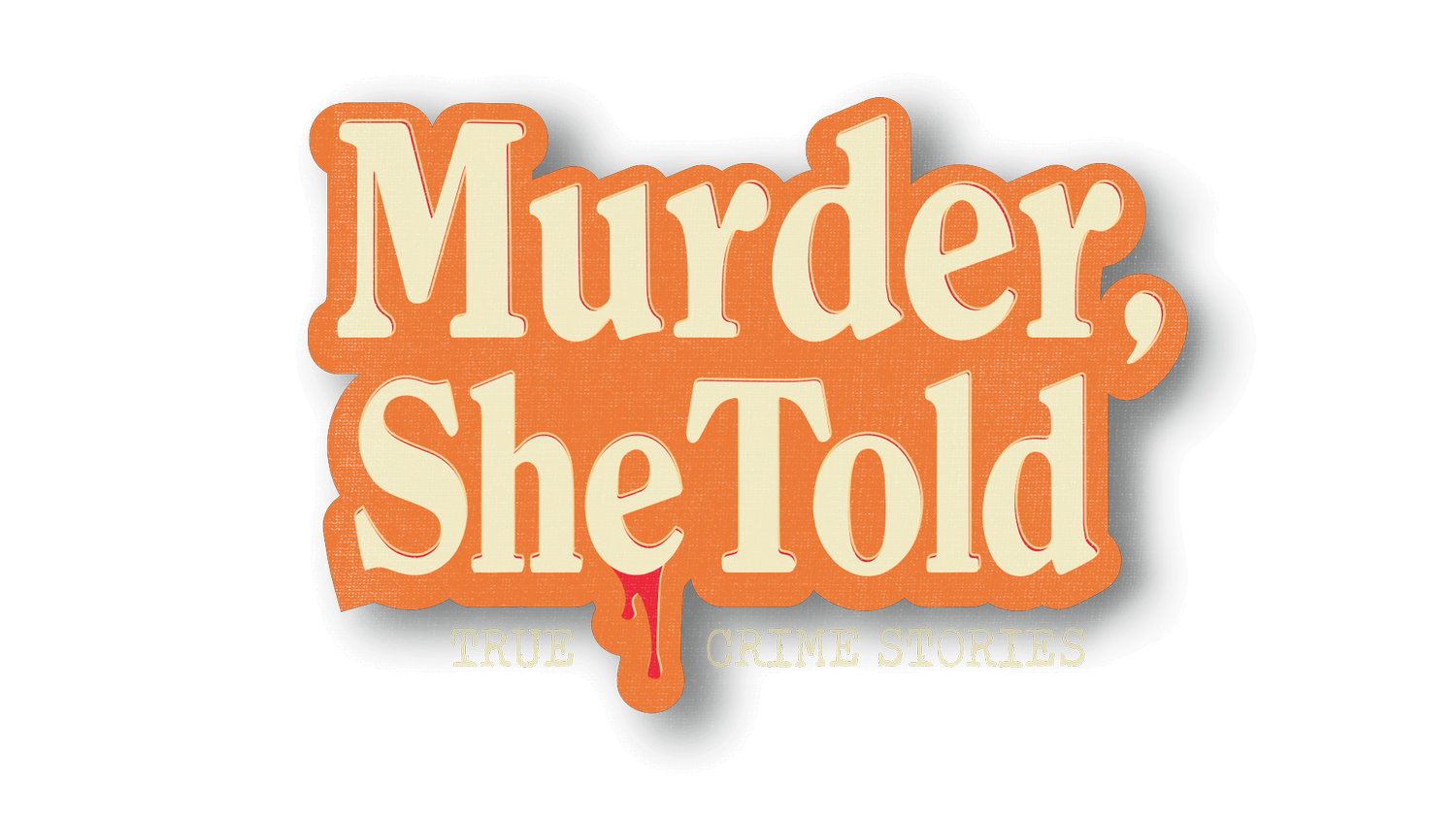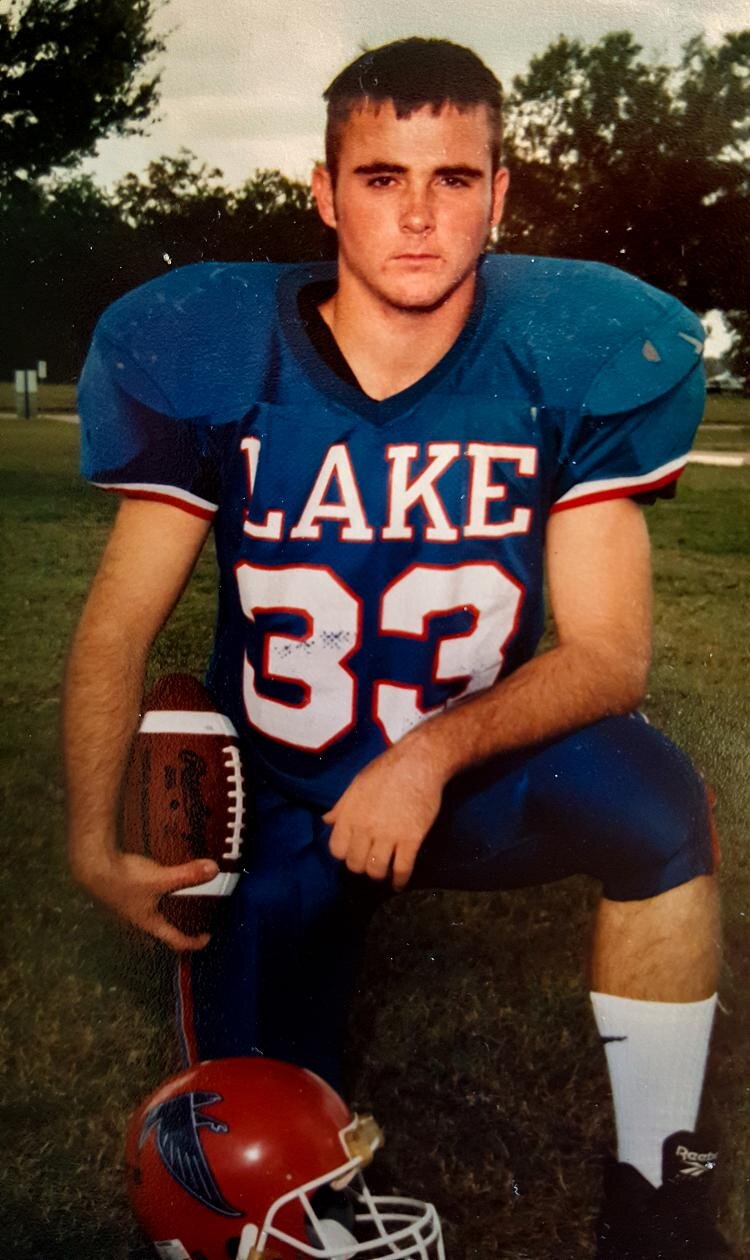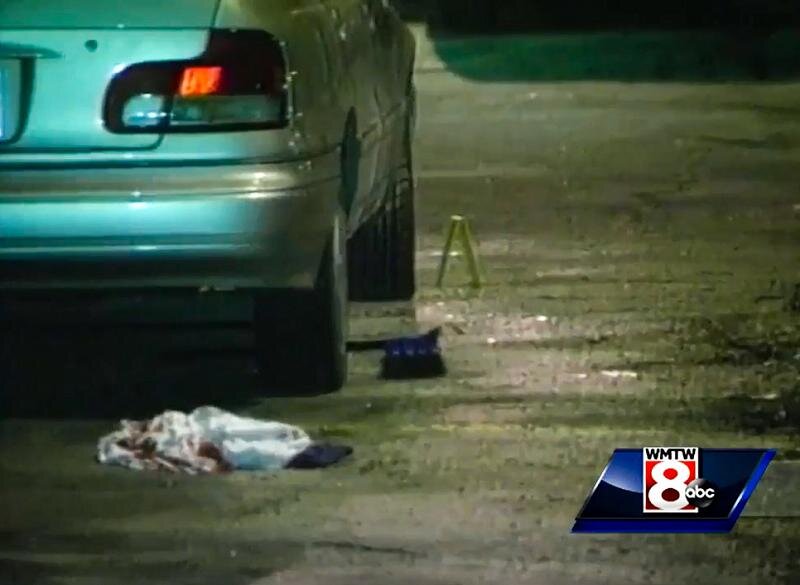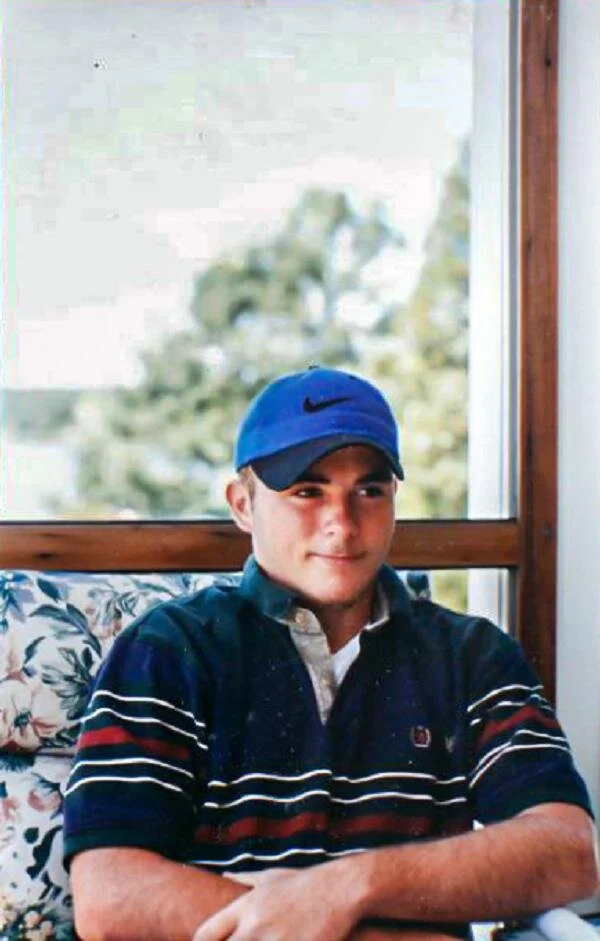Searching For Answers: The Murder of Robert Joyal, Part Two
Robert Joyal, Clear Lake Falcons football uniform (Houston, TX)
This is part two in a two-part series on the unsolved murder of Robert Joyal. Click here for one.
Day of Robert’s move out
When 18-year-old Robert Joyal closed the door on his Ford Bronco, packed full of his belongings and groceries his mother bought him earlier in the day, a huge grin spread across his face. A grin his family knew well. “This is what independence feels like. Full-on adult independence.”
The afternoon of April 3rd, 1998 was a bittersweet one for the Joyal family. Full of complicated hope, maybe a dash of fear—but mostly confidence that the family was ultimately moving towards growing closer, despite physically moving farther apart.
When Rob drove away that day, confident about his future, nobody knew that his first night of freedom would actually be his last.
A tragedy at a late night hang-out spot in Portland
By the time he got to his new apartment, Rob and his friends had plans: They were going out to celebrate his new-found freedom, and if you were under 21, Metropolis Dance Club on Forest Avenue in Portland was the place to be.
That’s where the trouble began.
At Metropolis, Rob’s friend, Michael Atienza, got into a verbal argument with another group of teens and young men. Some say the argument was over a girl.
The place to go to after the club was the 24-hour Denny’s on Congress Street. Teens would end up there, order fries and 10 waters and hang out in the parking lot after the clubs were closed. The night of April 4th was no different.
The rival group left Metropolis first, but the conflict was not over. When Rob and Michael and the rest of their group made it over to Denny’s around 1:00AM, they found three cars of guys waiting for them in the parking lot.
A fight between Michael and PT broke out, others joined in, and Rob ended up fighting with a kid named Kevin Janosco. Rob and his friends - there were about 6 of them - got pulled apart, and they were all engaged in their own isolated fights in the parking lot.
A knife—a ten-inch, double-edged serrated knife—was plunged into Rob’s back three times. Shortly after, somebody yelled “cops,” and everyone dispersed faster than it started. Rob was left in a pool of blood. He didn’t even make it to Maine Medical Center.
Accounts from that evening described Rob’s final moments: he staggered, gasping for air with blood in his mouth and fell to the ground. He called out his girlfriend’s name. But the medical examiner, however, said that based on his wounds, he would have died instantly: one of the knife blows had severed part of his spine.
But no matter what the story, the outcome is still the same. A teenager was murdered, and the killer had run away. But who was that killer?
Tons of people, no witnesses
At Denny’s that night there were perhaps 100 people in the parking lot, depending on which source you believe, and as many as 30 involved in fights. Some were inside eating, some were in their own cars, and some were just hanging out in the parking lot.
Initial police investigation included interviews of about 60 people, and they were able to piece together some of the details of the evening, but things were murky. Portland Deputy Chief Mark Dion told the press “It’s a classic case of ‘he said she said’ multiplied by many factors.” But the three cars that were waiting for Rob and his friends were identified, and their occupants were unmasked.
Violent “Tiny Raskal Gang” involved
The police made a stunning revelation: this rival group was no ordinary bunch of rowdy teens, but rather a group all involved with organized crime who were either affiliated with or full-fledged members of the Southeast Asian Gang called The Tiny Raskals.
Investigation revealed that in the first car, a red Mustang, was 15-year-old Seiha Srey, Sam Kim and his brother, Soeun, as well as Tanna Ork, a cousin of the Kim brothers who lived in Lowell, Massachusetts (one of the primary hubs for the gang).
In the second car, a blue compact, was PT, Kevin Janosco, and at least three other people.
And finally, a dark Toyota car with Massachusetts plates, was driven by Voeun Kim (another Kim brother) with three guys from Boston. This was the vehicle that had the weapons in its trunk.
Murder weapon found
The knife that killed Rob was left behind in the parking lot. Another knife was found on the side of the road near the parking lot, thrown from the window of PT’s fleeing car.
Portland Police Chief Michael Chitwood later told the press: "This is not a kitchen knife that you use to butter your bread. This weapon and another knife confiscated at the scene were there for one reason - and one reason only - to hurt people.”
Fingerprints were pulled from the knife that killed Rob, and though they would play a part in the future of this case, Portland police said that they could not definitively link them to anyone.
That same night PT along with Kevin Janosco, who fled the scene in PT’s blue compact, was taken into custody for questioning. Rob’s blood was all over PT’s jacket. They were both released the following day.
The other cars with the Kim brothers, Seiha Srey, the men from Boston and Tanna Ork fled the scene and hid in one of the brother’s apartments.
A suspect emerges
Within two days of Rob’s murder, a suspect started to emerge.
On April 6th, 15-year-old Nicole Glover came to the Portland Police Station with her parents to talk to them about a phone call she received about 13 hours after Rob’s death. Nicole said that she was talking to 15-year-old Seiha Srey, whom she considered a friend, and during their conversation he started talking about the melee at Denny’s the night before. Seiha was with the group of Tiny Rascals members that night and fled the scene with the other guys from Boston.
She said he confessed to her over the phone that he’d stabbed Rob after somebody used racial slurs against him and his friends.
Seiha initially told police that he wasn’t even at Denny’s that night.
Another witness, one of Seiha’s friends, came forward and said that Seiha asked him to be his alibi to back up the lie he told police.
Additionally, Tanna Ork became an important witness for the Portland police dept. Although Tanna’s initial statement to police was that he wasn’t at Denny’s at all, after he returned home to Lowell, Mass, he was picked up for an unrelated crime and divulged to Lowell PD that he knew more about the crime than he had initially said.
Portland police teamed up with a detective specializing in gangs in Lowell, and set out to interview Tanna. Portland Police Detective Scott Pelletier travelled to Lowell, and they learned that the night of the murder, 18-year-old Tanna was in Portland visiting his cousins (the Kim brothers) for a birthday celebration. He was out with them the whole night, ended up at Denny’s with them, saw Rob fighting with Kevin and then saw Seiha come up, knife in hand, and stab Rob in the back.
This was the information the police needed to move forward. Between Tanna’s eyewitness testimony and Nicole’s account of Seiha’s phone call, police were confident that Seiha Srey was the killer, and on Thursday, May 7, 1998, one month after Rob’s death, Seiha Srey was charged with murder.
The case against Seiha crumbles
The first thing that the defense team went after was Nicole’s testimony. Lilley presented contradictory testimony from a high school teacher at Nicole’s school, who said he had overheard Nicole saying that she knew that Seiha didn’t stab Joyal. Lilley also further challenged Nicole’s account by pointing out that in her own interview with police, she asked the detective if he knew who had killed Joyal, an odd question considering she had heard the confession of the murderer herself.
Next, Lilley presented an alternate killer theory based on a first hand witness account. One of Rob’s friends, Michael Petty, a young man who was in the parking lot that night, said that he saw Kevin Janosco holding something and striking Rob’s back with downward motion, and although he didn’t see the blade of the knife itself, he believed that it was Kevin who had stabbed Rob.
The prosecution had dismissed Michael’s testimony as not credible when key details didn’t match up: he said Rob’s jacket was down when he was stabbed, but it was actually up over his head. Although it was reasonable to believe that Janosco was the killer considering he was one of the last known people to be in contact with Rob as they were fighting, how did he come into possession of the knife as he was wrestling and scrapping with Rob?
Next the defense turned its attention to the fingerprint on the knife. The prosecution’s forensic expert witness testified that the print on the murder weapon was poor quality and couldn’t be used to identify or rule out Seiha. The defense hired their own fingerprint expert, who examined the print on the murder weapon, and he testified that not only was the print usable, it belonged to a man named “Marseird El”, another person in the parking lot that night, a revelation that stunned the prosecution.
Perhaps most damning of all is the circumstances and initial testimony of key prosecution witness, Tanna Ork. Initially Tanna was interviewed by Lowell, Massachusetts police, and he told them that he saw the stabbing, and that the perpetrator was someone else entirely: a 14-year-old Vietnamese boy from Boston. Lowell PD notified Portland PD, and when they came down to conduct their own interview, Tanna changed his story and fingered Seiha instead, becoming the prosecution’s star witness.
The prosecution did not reveal this information surrounding the initial interview to the defense during discovery, and it wasn’t until one week before trial that this information was divulged, and in an incredibly unorthodox move, Seiha’s attorney put the district attorney Fernand Larochelle himself on the stand to answer questions about why this exculpatory evidence was not provided to the defense in a more timely fashion.
Two men might hold the keys, but at what price?
Two other names that came up in the legal process were Ros Choun and Seoun Kim (one of the Kim brothers there that night). Ros and Seoun were charged with home invasion in Portland—burglarizing an apartment and threatening the people inside. They were two of a group of four men who burst into a Portland party in March of 1999, ordered 16 people to the floor, threatened them with guns and a machete, and took off with thousands of dollars worth of cash, jewelry and other valuables. Both of them said that they knew the identity of Joyal’s killer, and both of them insisted on reduction of their charges in exchange for information. The state said that they were not willing to reduce the charges against the men, and the preliminary interviews with the men yielded no further pertinent information. Lilley said that the reason that the state was unwilling to negotiate with these men was that they would further undermine the state’s case by identifying an alternate suspect.
The defense made a convincing claim that the lies and stories circling the case were all made to cover up the identities of the real killer, likely a full-fledged member of the Tiny Raskal Gang. Seiha was not an official member, was one the only people in their group that was under 18, and Lilley said that he was being set up to take the fall for a crime he did not commit.
A debate rages about Seiha attending public high school in Cape Elizabeth
A very unusual situation had arisen. Nance Monaghan, a private investigator hired by Seiha’s attorney, had gotten legal guardianship over Seiha. She said that the reason for the move was to enable him to have distance from other kids in school at Deering High School that were witnesses in his pending criminal case.
She was a resident of Cape Elizabeth, and she filed paperwork to enroll Seiha at Cape Elizabeth High School. The plan was for Seiha to stay with her five days a week and to return to his family in Portland on the weekends. The principal initially accepted Seiha, but after a firestorm of angry calls from parents countering that his presence at the school would constitute a major distraction, the principal reversed his decision and instead made arrangements for Seiha to have a private tutor. This saga continued, first to the superintendent of the school district then to a county judge and ultimately it landed at the feet of the school board, and they decided in a unanimous 7-0 decision to disallow Seiha’s enrollment. Their 4.5 hour hearing was conducted in secret, so we will never know the full context and rationale of their decisions, but I think the unanimous decision speaks to the absolute confidence of the board that they had reached the right decision. I suspect that the confidential records relating to Seiha that were available to the board (but not to the public) made the decision for them.
State dismisses the murder charge against Seiha
On Wed, March 1, 2000, nearly two years after he was indicted, the charges against Seiha Srey were dropped. The state, in essence, admitted that they had failed to meet the standard of guilt required for a successful conviction: beyond a reasonable doubt. Seiha was free.
The prosecution had dismissed the case against Seiha, but the police stood firm. They believed that Seiha was responsible, and though they acknowledged that they might not have the evidence necessary for a conviction, they reserved the right to come after him again in the future should additional information arise.
Years later, Seiha dies a violent death
In the years following, Seiha was convicted as several other violent crimes: two assault charges, burglary, failing to yield to pedestrian, misdemeanor weapons charges, and parole violations. He was sentenced to five years and 6 months with all but 24 months suspended (meaning that he would serve only a year and a half). His biggest concern, though, was that he would be deported back to Cambodia.
He ultimately served two year, was released in 2003, and was not deported.
In October of 2007, 25-year-old Seiha’s criminal behavior came to an end. After a dispute over a $7,500 drug debt at a party, Seiha was shot in the head and killed after he shot at the other party and tried to flee the scene.
Whatever secrets Seiha Srey was holding onto, went with him to his grave.
As interest in the case fades, Robert’s brother steps up
With Seiha’s death, interest in the case plummeted. Seiha was charged with the crime, and for many people, Seiha’s indictment was proof enough that he was responsible for Rob’s death. After all, most criminal charges result in either guilty pleas or guilty verdicts. Both the police and the public likely believe that with Seiha’s death went any chance for truth or justice.
Despite people thinking this case is solved, nobody has ever been convicted of murdering Robert Joyal. As of this recording, Rob’s case isn’t listed on the most current “Portland Police Department, Cold Cases Homicides” list, updated on April 19th of this year. The only regurgitated blurb on the Portland police facebook page is from 3 years ago on the 20th anniversary of his death. There haven’t been any shares about his case since.
Around the 20th anniversary Marc knew he needed to step up and try and make a difference in his brother’s case. Time continued to pass and no progress was being made. If the family didn’t step up and fight, who would? He started petitioning media outlets to cover his brother’s story, hoping to see Rob’s name in the headlines again and reignite interest in the case in hopes that maybe enough time had passed for people to be ready to talk.
Many crimes, no consequences
The murder itself was not the only crime committed that night. There were assaults with a deadly weapon, there were people who conspired to commit a cover-up, there were those who were hindering apprehension, and rampant obstruction of justice, but other than Seiha, not one person was charged with a single crime in connection with Rob’s death.
Other than Seiha, the only other people to face consequences were the managers of the Denny’s. Faith Joyal, Rob’s mother, filed a civil lawsuit against them for not providing adequate security.
Gang’s wall of silence
In the months following the murder in the summer of 1998, Rob’s dad ran into Kevin Janosco in the South Portland Maine Mall. Kevin told him that he didn’t see who stabbed Rob, but that he knew it wasn’t Seiha. He also left Robert with these chilling words: “Nobody will ever find out who did it because nobody will ever tell.”
Marc needs our help
I can’t help but think back to Marc’s childhood story about Rob’s last minute change of plans to play basketball in the driveway with his little brother, building up his confidence and making him feel loved. He protected him, believed in him, and comforted him. Today, 30 years later, the roles are reversed, and I can’t help but admire the strength and tenacity that Marc has shown in his fight for justice for Rob.
Rob’s troubled life as a youth is not unique. There are millions of kids just like Rob who struggle to find their way. Perhaps if we, as Americans, become more tolerant of our differences, we might find that we have more in common than you might think.
What you can do
If you’re holding onto any information or think you might know something about the 1998 murder of Robert Joyal, I urge you to call the Portland police at (207) 874-8584 or submit a tip to the Maine State cold case unit. If you feel more comfortable talking with somebody like me, please don’t hesitate to reach out to me and I can act as a liaison for you. I will keep you anonymous if you request.
If you have connections to high school alumni groups in the greater Portland area, share this blog with them or any of the posts about Rob’s case on the Murder, She Told Facebook page. Students from schools like Deering, Gorham, South Portland, and Portland could have been there or heard something, especially classes of 1996-2000.
If you have a printer, live in the greater Portland area and have some spare time, help Marc by putting up these flyers made by the family.
Connect with the family’s Facebook page and join Rob’s group for updates.
Connect with the Maine Cold Case Alliance
Connect on instagram @MurderSheToldPodcast
Click here to support Murder, She Told.
Crime scene photo, April 1998, (Denny’s in Portland, ME)
Crime scene photo, April 1998, (Denny’s in Portland, ME)
Seiha Srey (left) with defense attorney Daniel Lilley (right)
Tiny Raskal Gang (TRG) hand sign
Marc Joyal-Myers
Faith Joyal
Faith Joyal and Marc Joyal-Myers
Sources For This Episode
Newspaper Articles
Various articles, predominantly from the Bangor Daily News and the Portland Press Herald as well as Kennebec Journal, Morning Sentinel, and The Boston Globe. Authors include Alan Clendenning, Ann Kim, Bill Nemitz, David Connerty-Marin, David Hench, Elbert Aull, Eric Blom, Gillian Graham, Gregory Kesich, Jason Wolfe, John Richardson, Joshua Weinstein, Josie Huang, Matt Byrne and Gillian Graham, Peter Pochna, Susan Rayfield, Suzanne Delcamp, and Tess Nacelewicz.
Full listing here.
Online Articles
'We will always miss Robert…' (News Center Maine), 4/3/2018, by Chris Rose
'Police search for new evidence…' (AP News), 4/4/2018, by AP
'Police seek information…' (WGME), 4/4/2018, no author credited
'20 years ago, a Maine teen…' (Bangor Daily News), 4/4/2018, by user 'CBS 13'
'Portland police ask for help…' (Portland Press Herald), 4/4/2018, by John Richardson
'Portland Police Seeking Information…' (Portland Maine Police Department), 4/4/2018, by user 'Portland Maine Police Department'
'Portland Police asking for help…' (WABI 5), 4/5/2018, by user 'WMTW'
'Two decades later, the sting…' (Central Maine), 4/8/2018, by Gillian Graham
'Portland Police Reinvestigate…' (Gorham Times), 4/19/2018, by Sheri Faber
'Robert Joyal was killed 20 yrs ago…' (Reddit), 8/8/2018, by user 'marcjm1'
'Cold case experts revive…' (Crime Online), 8/13/2018, by Leigh Egan
'Dozens of People Witnessed His…' (Medium), 4/15/2021, by Corey Sobell
Video sources
'We will always miss Robert…' (News Center Maine), 4/3/2018
'Portland Police asking for help…' (WABI 5), 4/5/2018
'Robert Joyal's brother speaks out…' (YouTube), 4/4/2018
'Slaying Victim's Mother Speaks' (YouTube), 10/30/2007
'Nationwide proposal could help solve cold cases' (YouTube), 12/20/2018
Interviews
Marc Joyal-Myers, Robert’s brother
Photos
Various photos from news sources and several provided by the Joyal family.
Credits
Created, researched, written, told, and edited by Kristen Seavey
Research, writing, photo editing support by Byron Willis











